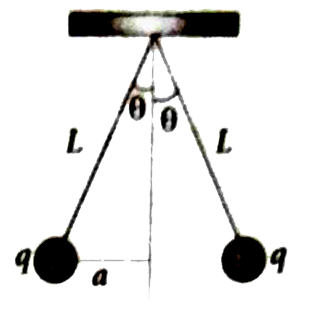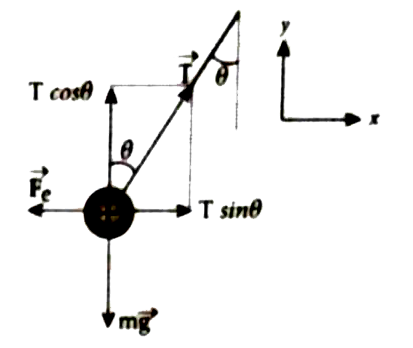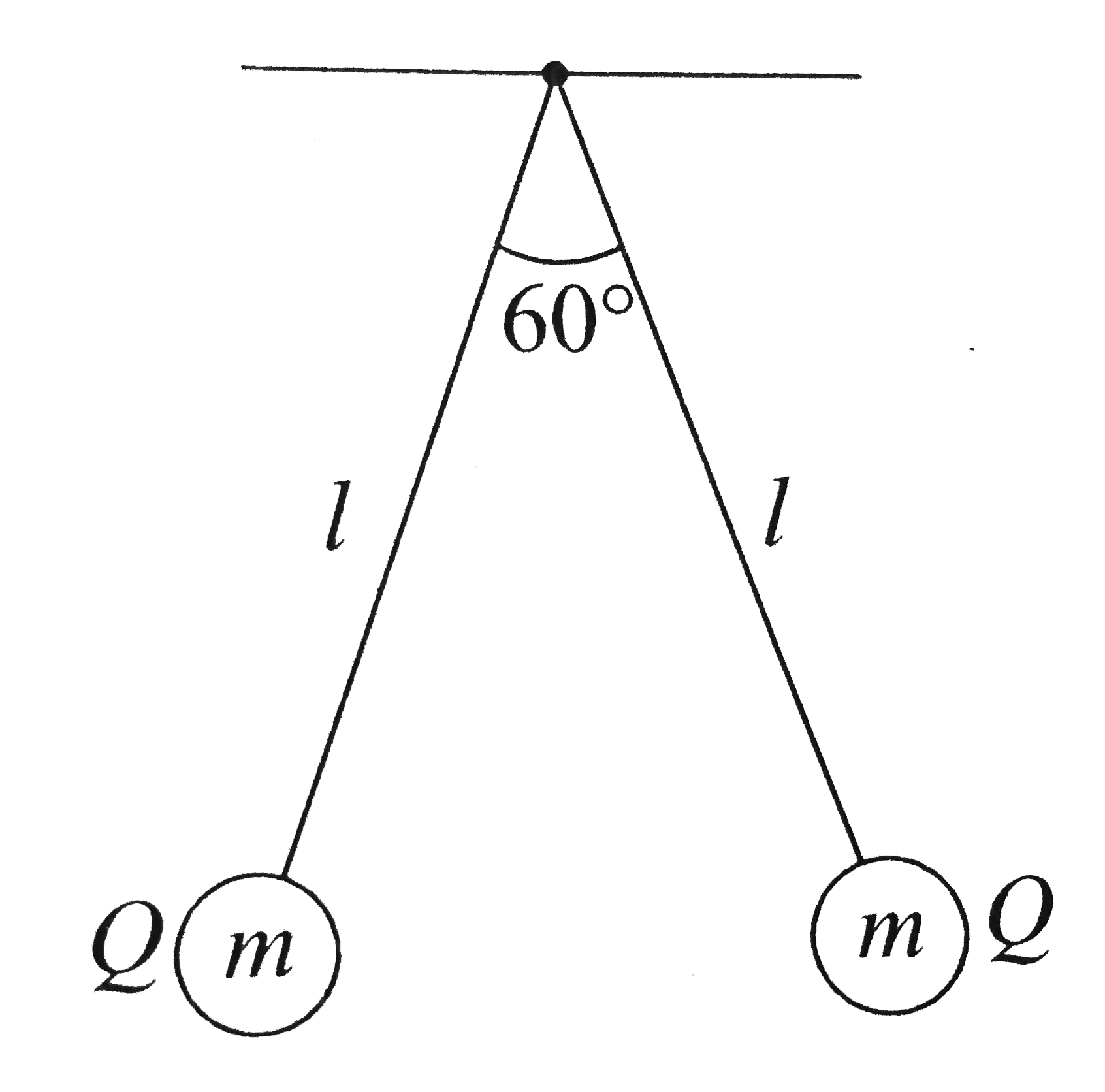Two small -sized identical equally charged spheres each having mass 1 mg are hanging in equilibrium as shown in the figure . The length of each string is 10 cm and the angle θ is 7∘ with the vertical . Calculate the magnitude of the charge in each sphere . (Take g =10ms−2)

If the spheres are neutral the angle between them will be 0∘ when hanged vertically . Since they are positively charged spheres , there will be a repulsive force between them and they will be at equilibrium with each other at an angle of 7∘ with the vertiction. We can draw a free body diagram for one of the charged spheres and apply Newton.s second law for both vertical and horizontal directions . The free body diagram is shown. In the x -direction the acceleration of the charged sphere is zero . Using Newton.s second law (→Fm=m→a) , we have T sin θˆi−Feˆi=0
Tsinθ=Fe
Here T is the tension acting on the charge due to the string and Fe is the electrostatic force between the two charges . In the y -direction also the net acceleration experienced by the charge is zero . T cosθˆj−mgˆj=0
Therefore T cos θ=mg . By dividing equation (1) by equation (2) , tanθ=Femg
Since they are equally charged the magnitude of the electrostatic force is
Fe=kq2r2 where k =14πε0
Here r = 2a = 2L sinθ. By substituting these values in equation (3) ,
tanθ=kq2mg(2Lsinθ)2
Rearranging the equation (4) to get q
q=2Lsinθ√mg tanθk=2×0.1×sin7∘×√10−3×10×tan7∘9×109
q=8.9×10−9C=8.9nC

Topper's Solved these Questions
- ELECTROSTATICS Book:FULL MARKSChapter:ELECTROSTATICS Exercise:Textual Evaluation Solved (Multiple choice questions : )
Explore 15 Videos
- ELECTROSTATICS Book:FULL MARKSChapter:ELECTROSTATICS Exercise:Textual Evaluation Solved (II. Short Answer Questions : )
Explore 21 Videos
- DUAL NATURE OF RADIATION AND MATTERBook:FULL MARKSChapter:DUAL NATURE OF RADIATION AND MATTERExercise:ADDITIONAL QUESTIONS -( ADDITIONAL NUMERICAL PROBLEMS : )
Explore 10 Videos
- MAGNETISM AND MAGNETIC EFFECTS OF ELECTRIC CURRENT Book:FULL MARKSChapter:MAGNETISM AND MAGNETIC EFFECTS OF ELECTRIC CURRENT Exercise:ADDITIONAL QUESTIONS SOLVED - NUMERICAL PROBLEMS :
Explore 4 Videos
Similar Questions
Two identical point charges'of magnitude -q are fixed as shown in the figure below. A third charge +q is placed midway between the two charges at the point P. Suppose this charge is displaced a small distance from the point P in the directions indicated by the arrows, in which direction(s) will +q be stable with respect to the displacement?

View SolutionWhat is meant by quantisation of charges ?
View SolutionIf a light of wavelength 4950 Å is viewed as a continuous flow of photons, what is the energy of each photon in eV ? (Given h=6.6×10−34Js, c =3×108ms−1)
View SolutionThe radius of the first orbit of hydrogen atom is 0.5 Å. The electron moves is an orbit with a uniform speed of 2.2×106ms−1. What is the magnetic field produced at the centre of the uncleus due to the mation of this electron ? Use μ0=4π×10−7Hm−1 and electric charge =1.6×10−19 C
View SolutionTwo small spheres, each having a mass of 20 g, are suspended form a common point by two insulating strings of length 40 cm each. The spheres are identically charged and the speration between the balls at equilibrium is found to be 4 cm . Find the charge on each sphere.
View SolutionTwo identical small charged spheres, each having a mass m, hang in equilibrium as shown in fig. the ligth of each string is l, and the angle made by any string with the vertical is theta . Find the magnitude of the charge on each sphere.
View SolutionTwo positively charged sphere of masses m_(1) and m_(2) are suspended from a common point at the ceiling by identical insulating massless strings of length l . Charges on the two spheres are q_(1) and q_(2) respectively. Equilibrium both strings make the same angle theta with the vertical. then
View SolutionTwo positively charged spheres of masses m1, and m2 are suspended from a common point at the ceiling by identical insulating massless strings of length l. Charged on the two spheres are q1 and q2, respectively. At equilibrium both strings make the same angle θ with the vertical. Then
View SolutionTwo identical spheres, each of mass m, are suspended from a point by threads. Each sphere carries a charge q. If the angle between the threads is very small, prove that in equilibrium, the distance between the centres of the two spheres is, x=((q^(2)l)/(2pi epsilon_(0)mg))^((1)/(3))
View Solutionदो छोटे बिंदुवत गोले प्रत्येक का द्रव्यमान 200 g है, एक उभयनिष्ठ बिन्दु से दो कुचालक धागों जिनकी प्रत्येक की लम्बाई 40 cm है द्वारा लटकाये गये हैं। दोनों गोले समान आवेशित हैं तथा साम्यावस्था में इनके बीच दूरी 4 cm. पाई गई है। प्रत्येक गोले पर आवेश ज्ञात कीजिए।
View SolutionTwo small balls, each having equal positive charge Q are suspended by two insulationg strings of equal length l from a hook fixed to a stand. It mass of each ball =m and total angle between the two strings is 60∘m, then find the charge on each ball.

View SolutionTwo identical, small, charged spheres, each having a mass of 4.0xx10^(-2) kg hang in equilibrium as shown in Fig. 22-10a. The length of each string is 1.5m and the angle theta is 37.0^(@) . Find the magnitude of the charge on each sphere.
View Solutionदो समान आवेशित गोले एक दूसरे से वायु में 0.6m की दूरी पर रखे है इनके बीच लगने वाला प्रतिकर्षण बल 10 mg भार है तब प्रत्येक गोले पर आवेश होगा | (g=10मी./से.2)
View SolutionTwo small spheres, each having a mass of 20 g, are suspended form a common point by two insulating strings of length 40 cm each. The spheres are identically charged and the speration between the balls at equilibrium is found to be 4 cm . Find the charge on each sphere.
View SolutionTwo small spheres each of mass 10 mg are suspended from a point by threads 0.5 m long. They are equally charged and repel each other to a distance of 0.20 m. The charge on each of the sphere is (a)/(21) xx 10^(-8)C . The value of 'a' will be _______. [Given g=10ms^(-2) ]
View Solution

